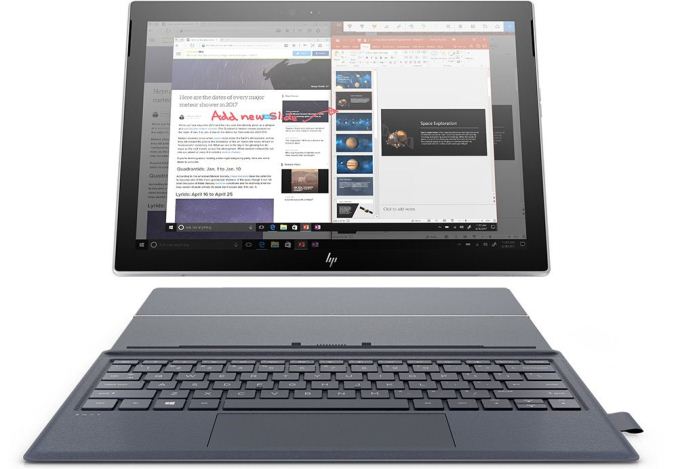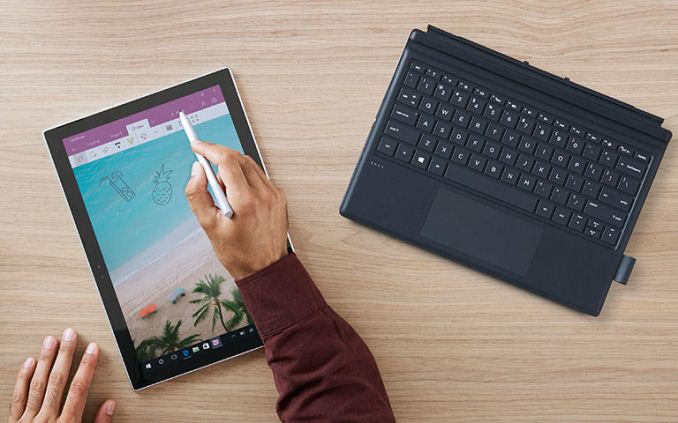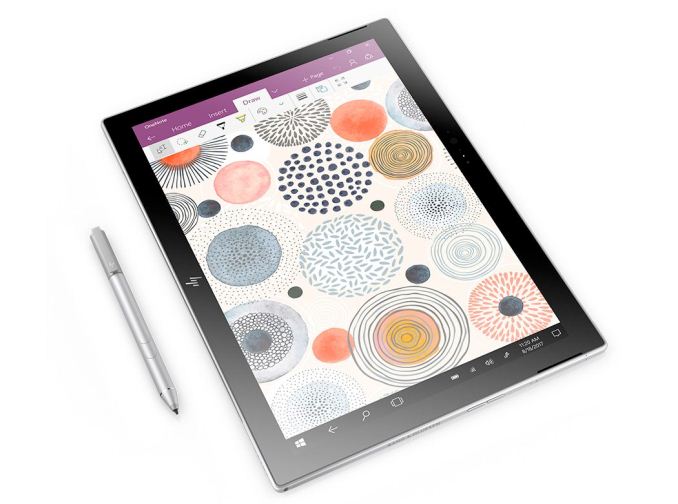HP’s Snapdragon 835-Based Envy X2 2-in-1 Available for Pre-Order, Starts at $999
by Anton Shilov on February 24, 2018 10:00 AM EST- Posted in
- Notebooks
- Systems
- HP
- 2-in-1
- Snapdragon 835
- Windows 10 S
- SD835
- HP Envy x2
- Envy x2

HP has started to take pre-orders on its new Envy X2 2-in-1 notebook based on Qualcomm’s Snapdragon 835 SoC and Windows 10 S. The 12.3” device is designed as a thin always connected unit, and rated for up to 22 hours on one charge. The price of the new Envy X2 is higher than we imagined when these devices were first announced: it starts at $999.
The 2018 HP Envy X2 2-in-1 detachable laptop comes with a 12.3” WUXGA+ touch-enabled display covered with Corning Gorilla Glass. The system runs the Qualcomm Snapdragon 835 SoC equipped with 4 GB of LPDDR4-3733 DRAM and 128 GB of eUFS storage (models with enhanced DRAM and storage are expected to be available later). The PC’s physical interfaces include one physical USB 3.1 Type-C header (with DisplayPort and USB Power Delivery support), a microSD card reader, and a 3.5-mm TRRS audio input. Wireless connectivity capabilities comprise of a 2x2 802.11ac Wi-Fi module with Bluetooth 5, and the built in Gigabit LTE modem from the SoC. The built-in SoC modem is meant to be one of the key features of the Envy X2 - it makes the device always connected in all areas with 3G and/or 4G networks, which essentially means everywhere in well-developed countries. For imaging, the device uses a 13 MP rear camera and a 5 MP front-facing camera.
The new Envy X2 is equipped with a 49.33 Wh battery that is rated to enable up to 19 hours of continuous video playback (at 150 nits brightness) or up to 22 hours of mixed-use workloads (HP does not tell how it tested these).
When it comes to portability, the HP Envy X2 is in line with professional tablets and advanced thin-and-light notebooks. The tablet itself it is 6.85 mm (0.27”) thick and weighs 698.5 grams (1.54 lbs), which is comparable to Apple iPad Pro 12.9”. When outfitted with a keyboard, the weight of the new Envy X2 bumps to 1.211 kilograms (2.67 lbs), which is similar to fully-fledged 13”-class laptops.
HP lists the S835 as running at 2.2 GHz base and 2.6 GHz turbo, which is typically how we describe an x86 PC, not a smartphone SoC: the S835 has two sets of cores, normally listed as 1.90 GHz on the efficiency cores and 2.45 GHz on the performance cores, neither of which correlates to HPs listing. So either this is a faster Snapdragon S835 bin, or there is miscommunication in the specification sheet. In this form factor there is a better opportunity for more cooling, which would be suitable for a higher frequency bin of SoC. But nonetheless, the 2.2-2.6 GHz listed on HP's website is not telling the whole story.
| Specifications of the HP Envy X2 (2018) | ||
| Model 12-e011nr | ||
| Display | 12.3" 1920×1280 187 PPI |
|
| CPU | Qualcomm Snapdragon 835 4 x Kryo 280 Performance (2.2 GHz - 2.6 GHz) 4 x Kryo Efficiency (? GHz) |
|
| Graphics | Adreno 540 GPU at 710 MHz | |
| RAM | 4 GB | |
| Storage | 128 GB eUFS | |
| Wi-Fi | Qualcomm WCN3990 2×2 802.11ac Wi-Fi |
|
| Bluetooth | Bluetooth 5 | |
| WWAN | Qualcomm X16 Gigabit LTE | |
| USB | 3.0 | 1 × Type-C |
| Cameras | Front | 5 MP |
| Rear | 13 MP | |
| Other I/O | Microphone, stereo speakers, audio jack, trackpad, MicroSD card reader, etc. | |
| Battery | 49.33 Wh | |
| Battery Life | 19-22 hours | |
| Dimensions | Width | 292.8 mm | 11.53" |
| Height | 210.3 mm | 8.28" | |
| Thickness | 6.85 mm | 0.27” (tablet only) | |
| Weight | Tablet | 698.5 grams | 1.54 lbs |
| Tablet+KB | 1.211 kilograms | 2.67 lbs | |
Like all Envy-branded devices, the new Envy X2 is designed to offer a premium experience: it comes in a brushed aluminum enclosure, features an audio sub-system co-developed with Bang & Olufsen, has a full-size magnetically attached keyboard/cover, and a stylus supporting Windows Ink technology (it is plausible to assume that the pen supports at least 1024 levels of sensitivity, but HP has not formally confirmed that). This premium look and feel comes at a price.
The Envy X2 model with 4 GB of RAM and 128 GB of NAND flash storage costs $999.99 and will ship on March 9. By contrast, the ASUS NovaGo TP370 with 8 GB of RAM and 128 GB of storage is priced at $799, whereas Lenovo’s Miix 630 is also expected to start from $799. Apple’s iPad Pro 12.9” with 4 GB of RAM, 64 GB of storage, a 4G/LTE modem and a keyboard is priced at $1197 (a version with 256 GB of NAND, a keyboard and stylus costs $1347), evidently HP aims its new Envy X2 at the same segment.
The latest HP Envy X2 is a product of Microsoft’s new attempt to marry nearly full-sized Windows and ARM. For HP, this is the first device running an ARM SoC and Windows for PCs. Several years ago, HP did not support Microsoft’s Windows RT (the software giant’s previous failed shot for ARM) and decided to focus on Atom- and then Core M-based Envy X2 running Windows 8/8.1/10 instead (many of such systems cost less than $1000). This time HP decided to go with S835 in a bid to offer a sleek always-connected Windows 10 device with an extra-long battery life. Since it is an Envy, it is priced accordingly and it remains to be seen whether end users are willing to spend this amount of money on this device. Obviously, the new Envy X2 is always connected and can work for a long time on one charge, but in Windows 10 S environment it can only run either specially-optimized applications, or perform binary translation (or another form of emulation) for 32-bit x86 applications (64-bit x86 apps are not supported) which naturally results in reduced performance.
Related Reading
- Lenovo Unveils Miix 630 2-in-1: Windows 10 S, Snapdragon 835, Gigabit LTE, 20 Hrs
- ASUS Announces the NovaGo (TP370): A Snapdragon 835 based Windows 10 PC
- Microsoft Launches Windows 10 On ARM: Always Connected PCs
- Microsoft and Qualcomm Collaborate to Bring Windows 10 & x86 Emulation to Snapdragon Processors
Source: HP














42 Comments
View All Comments
Gunbuster - Saturday, February 24, 2018 - link
Wait did they even release benchmarks for 10 on arm yet? And now they expect people to preorder hardware?Makaveli - Saturday, February 24, 2018 - link
Nothing else to add most of the comments cover all the issues with this.MonkeyPaw - Saturday, February 24, 2018 - link
Unfortunately, like Windows 10 S, WOA is a problem looking for a solution, especially if this is the pricing scheme.Right now at B&H, you can get a 256GB 10.5" iPad Pro, Pencil, and keyboard for under $999. I know they aren't exactly the same, but I also know iOS will be nicely supported by developers today and 2 years from today, unlike anything WOA.
Hurr Durr - Saturday, February 24, 2018 - link
Cool it with sweeping generalizations. I have an application from the 8.1 days which is still actively developed, both on phone and on a box.vanilla_gorilla - Saturday, February 24, 2018 - link
When it applies to about 99% of cases it's ok to make a generalization.Hurr Durr - Sunday, February 25, 2018 - link
Time for ur mum joke I feel.MonkeyPaw - Saturday, February 24, 2018 - link
I don't think what I said was inaccurate. You may support the platform, but I think it's safe to say that very few developers do. MS started their own version of the "Appstore" in 2012, and to this day very few of the "popular" apps are available on the platform. I don't think anyone even realistically expects to find their favorite app on Windows 10. MS has tried too many times without any clear commitment, and with no mobile platform, what can they expect? To top it off, MS's take on the Appstore was quite unreliable for me. When I had a Surface 3, I recall the Store simply refusing to install any new apps, for no known reason. It was a problem in the Win 8.x days, too. You had to fix it by uninstalling a random app, or maybe the Store Troubleshooter fixed it. Android and iOS never have these issues. It's just not competitive.Hurr Durr - Sunday, February 25, 2018 - link
You`re repeating the mantra circa 8.1. Sure, it is in the runner-up position, but then the install base is huge and INCREDIBLY inert, and popular app situation(all 50 of them lol) has improved.eSyr - Saturday, February 24, 2018 - link
Well, if it uses UEFI with an ability to instal user certificate chains and has no restricitons regarding OS installations, it could be an interesting device.Sttm - Saturday, February 24, 2018 - link
$1000 and it has last years Phone SoC... ARE THEY F@#$%ing HIGH?